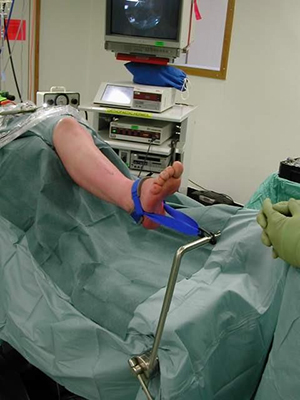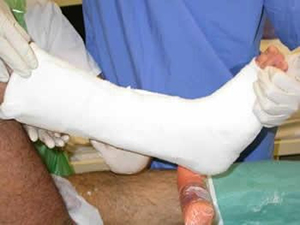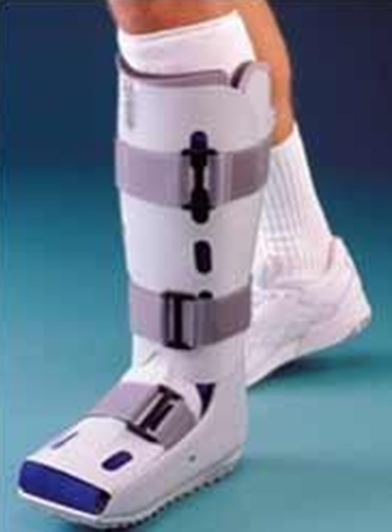
 An ankle arthrodesis or fusion is an operation to “fuse” or stiffen the ankle joint. There are two main ways of doing the operation.
An ankle arthrodesis or fusion is an operation to “fuse” or stiffen the ankle joint. There are two main ways of doing the operation.
The ankle may be opened up with cuts on either side, or a camera (arthroscope – ‘key-hole’ surgery) may be put in to the ankle to guide instruments. If it is possible to do the operation with an arthroscope, you usually recover more quickly and can probably walk on the ankle sooner.
However, this is not possible if the ankle is very deformed. The vast majority of cases are now performed with an arthroscope.
In either case, the joint is opened up and the joint surfaces removed and, if necessary, reshaped to correct a deformity. The joint is then put in the correct place and fixed with two or three screws. Overall there will be usually be two holes in the front of the ankle and two holes further up the inside of your leg (all less than 1cm).
It is sometimes necessary to put some extra bone into an ankle fusion to get it to heal and to fill any gaps in the fusion left by correcting deformity. Often this extra bone can be obtained from the bone that is cut out to prepare the fusion. Sometimes there is not enough bone from this and bone has to be taken from the tibia (shinbone) just below the knee.
Some people who have foot deformities have a tight Achilles tendon (“heel cord”), or weak muscles, or both. The Achilles tendon may be lengthened during surgery by making three small cuts in the calf and stretching the tendon.
Some people with deformities of the foot also have deformed toes. Again, these may be corrected at the same time or at a later operation.
HOW LONG WOULD I BE IN HOSPITAL?Most people who are reasonably fit can come into hospital on the day of surgery, having had a medical checkup beforehand if required. After surgery your foot will tend to swell up quite a lot, especially if you have had extra surgery such as a tendon transfer or toe straightening procedure. You will therefore have to rest with your foot raised to help the swelling to go down. This may take anything from 24 hours to a week. If you get up too quickly this may cause problems with the healing of your foot. Once the swelling goes down and the cuts on your foot are healing you can get up with crutches and go home. The physiotherapist will teach you how to walk with crutches. We will get you up as soon as possible! Most people are in hospital for 2-3 days. |
WILL I HAVE TO GO TO SLEEP (GENERAL ANAESTHETIC)?The operation is usually done under general anaesthetic (asleep). Alternatively, an injection in the back can be done to make the foot numb while the patient remains awake. Local anaesthetic injections do not always work and in that case you may have to go to sleep if the operation is to be done. The anaesthetist will advise you about the best choice of anaesthetic for you. In addition, local anaesthetic will be injected into your leg while you are asleep to reduce the pain after the operation even if you go to sleep for the surgery. You will also be given pain- killing tablets as required. |
FOLLOWING YOUR SURGERY
-
ON THE WARD
 A plaster splint down the back of your ankle and under your foot will be applied while you are asleep. This is only a half-plaster, to allow for swelling. You will be provided with crutches when you are discharged from hospital, and a physiotherapist will teach you how to use these.
A plaster splint down the back of your ankle and under your foot will be applied while you are asleep. This is only a half-plaster, to allow for swelling. You will be provided with crutches when you are discharged from hospital, and a physiotherapist will teach you how to use these.
You cannot put any weight through your plaster in the first two weeks. You can usually take some weight for balance once the wounds are healing well and the swelling is going down – usually about 10-14 days. It is very important that the leg remains elevated most of the time in the first 2 weeks. Do not wet or remove the plaster.
It is normal to expect:
-
SWELLING – This can be minimised by elevating your foot above your heart.
-
PAIN – You will receive a prescription for pain medication on discharge from hospital. Pain can also be minimised by elevating your leg.
-
BLEEDING – This always occurs. You may notice some oozing through the bandages.
You will need to wear a plaster or brace from your knee to your toes until the bones have healed – usually 6 weeks.
-
WHEN YOU GO HOME
By the time you go home you will have mastered walking on crutches without putting weight on your foot. 10-14 days after your operation you will be seen again by Dr. Sterling. Your plaster will be removed and the cut and swelling on your foot checked. If all is well you will be put into a “moon boot”. You should continue using your crutches.
About 8 weeks after your operation you will come back to for an x-ray. A few people’s ankles are already almost healed at his point, especially if they had an arthroscopy. If so, they may be able to start walking in the moon boot.
Another x-ray is taken at 12 weeks and the moon boot is then weaned.
Mobility slowly improves and the need for the support for the boot is reduced. Full Recovery from this surgery typically takes 9-12 months.
HOW SOON CAN I….
-
WALK ON THE FOOT?
As explained above, you should not walk on the foot for about 8 weeks after surgery. Dr. Sterling will advise you when you can start taking some weight on the foot. This is done with the protection of the provided “moon boot”.
-
GO BACK TO WORK?
If your foot is comfortable, and you can keep your foot up and work with your foot in a special shoe, you can go back to work within 3-4 weeks of surgery. On the other hand, in a manual job with a lot of dirt or dust around and a lot of pressure on your foot, you may need to take anything up to six months off work. How long you are off will depend on where your job fits between these two extremes.
-
DRIVE?
If you have only your left foot operated on and have an automatic car you can drive within a few weeks of the operation, when your foot is comfortable enough and you can bear weight through it. Most? people prefer to wait till the boot is removed and they can wear a shoe. (ie. After 3 months).
-
PLAY SPORT?
After your boot is removed you can start taking increasing exercise. Start with walking or cycling, building up to more vigorous exercise as comfort and flexibility permit. Obviously, the foot will be stiffer after surgery and you may not be able to do all you could before. However, many people find that because the foot is more comfortable than before surgery they can do more than they could before the operation. Most people can walk a reasonable distance on the flat, slopes and stairs, drive and cycle. Walking on rough ground is more difficult after an ankle fusion because the foot is stiffer. It is rare to be able to play vigorous sports such as squash or football after an ankle fusion.
IF YOU ARE CONCERNED:
|

